- MathNotebook
- MathConcepts
- StudyMath
- Geometry
- Logic
- Bott periodicity
- CategoryTheory
- FieldWithOneElement
- MathDiscovery
- Math Connections
Epistemology
- m a t h 4 w i s d o m - g m a i l
- +370 607 27 665
- My work is in the Public Domain for all to share freely.
- 读物 书 影片 维基百科
Introduction E9F5FC
Questions FFFFC0
Software
Abstract, Syntax, Audio of presentation and discussion 40 min.
Presented at Cognition and Language, Brno, Czechia, November 24-25, 2017.
Games as the Foundation for Universal Grammar
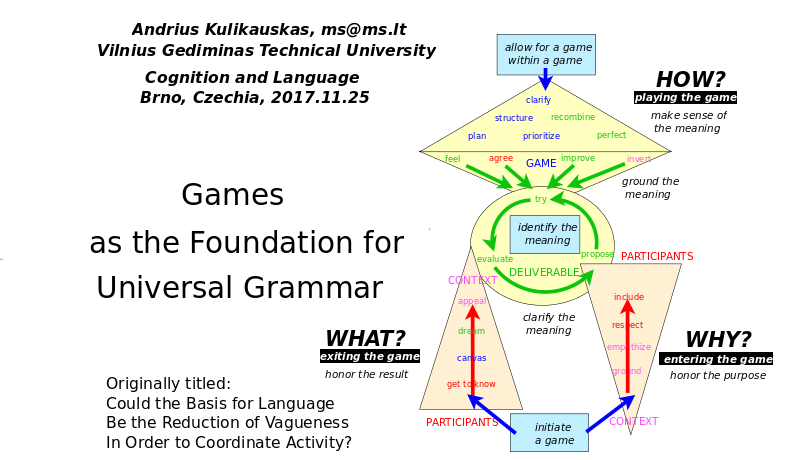
The original title for my talk was a question: "Could the Basis for Language Be the Reduction of Vagueness In Order to Coordinate Activity?" Having made some progress on this question, I will talk about my findings, and so accordingly, I name my talk: "Games as the Foundation for Universal Grammar".
I will start by noting the implausibility of traditional accounts of language as the transmission and construction of well defined assemblies of well defined terms. Instead, I consider our minds to be naturally vague, and I think of language as a means by which we reduce this vagueness for the sake of coordinating activity. I will propose that what makes us human is our ability to play games, that is, to create shared worlds which we enter and exit. I will show how every game is in principle the same in that it potentially consists of twenty four games. I will discuss how this universal framework is precisely what is needed for all manner of syntactic phenomena, and indeed, for Noam Chomsky's Universal Grammar.
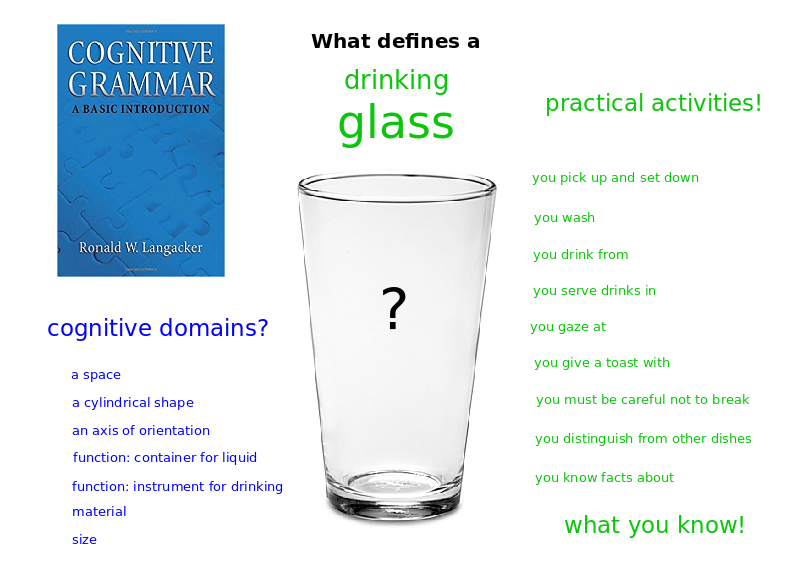
I will present an alternative to what I think is an erroneous assumption made in linguistics as well as analytic philosophy that language is well defined. In particular, linguists assume that words are well defined, which is to say, we know what they mean. For example, Ronald Langacker, in his book "Cognitive Grammar: A Basic Introduction", talks about the cognitive domains which we appeal to in talking about a glass, such as the space it takes up, the shape it has, its function as a container, its function as a means for drinking. But the fact is that none of us truly knows what we or others mean by the word "glass". And our lack of clarity would become obvious if the glass grew larger so that some of us would claim that it is a glass but others would argue that it is a container or a piece of furniture. Pragmatically, we don't need to know absolutely what we mean by glass because typically we're not interested in the concept of a glass or even a particular glass but what we really want is some water or simply to quench our thirst.
My alternative is to recognize that our thinking is incredibly vague and that our goal is simply to reduce that vagueness enough to coordinate our activity so that we might perform it satisfactorily. Thus we can think of a glass as one of many things that we can pick up and set down, that we can wash, that we can drink from, and that we can serve to others, which is presumably why it is tall and transparent, so that we can see from afar if it needs to be refilled. We can fulfill a request to separate the glasses from the plates in the sink, and in doing so we do not share a definition of what a glass is, but rather we each have our own quirky procedure for distinguishing a glass from other common objects. Indeed, the dictionary definition of a glass is nothing more than an institutional generalization of our personal rationalizations of our unconscious neural capabilities. We actually don't truly know what we mean by glass and that is the point of language in that it allows us to make explicit what we unconsciously know and what we consciously don't know.
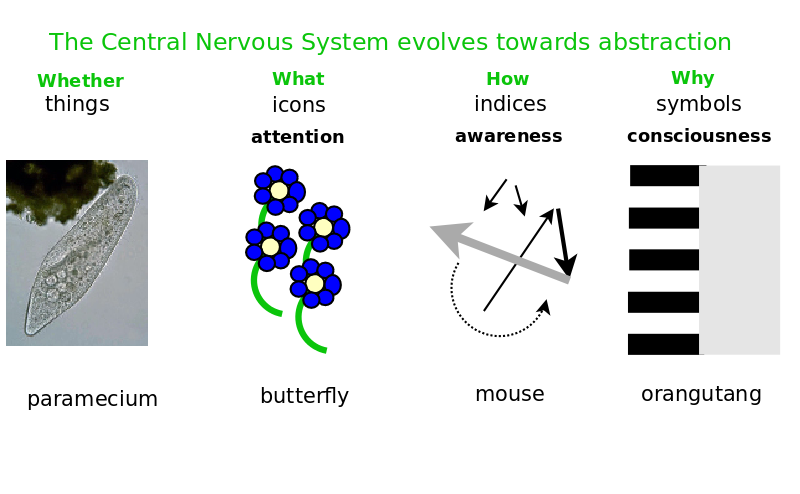
I will present an account of how the central nervous system has evolved to allow for a dialogue between two kinds of thinking, what Kahneman calls System 1 and System 2, and what I will call what we unconsciously know and what we consciously don't know, which I claim are the basis for semantics and syntax, respectively. The evidence by which cognitive linguists such as Lakoff argue for the embodied mind can likewise be used to argue for a disembodying mind which focuses ever more resources on what we don't know.
A single-celled paramecium engages the world directly by way of its receptors for light and chemicals. But a butterfly lives in a world of flowers, that is, a neural representation of the world in terms of sensorial images which it pays attention to. As neuroscientist Michael Graziano has noted, a mouse furthermore has awareness, in that it utilizes a model of attention which it can identify not only with its own attention, and thus be itself aware, but likewise model a cat's attention, and thus be aware of whether or not the cat is attending to the mouse. Thus the mouse lives an abstract world of indexical and causal relationships. But humans and perhaps the great apes can moreover be conscious, that is, we can choose what we wish to be aware of. We can focus on a symbol itself or focus on what it might refer to.
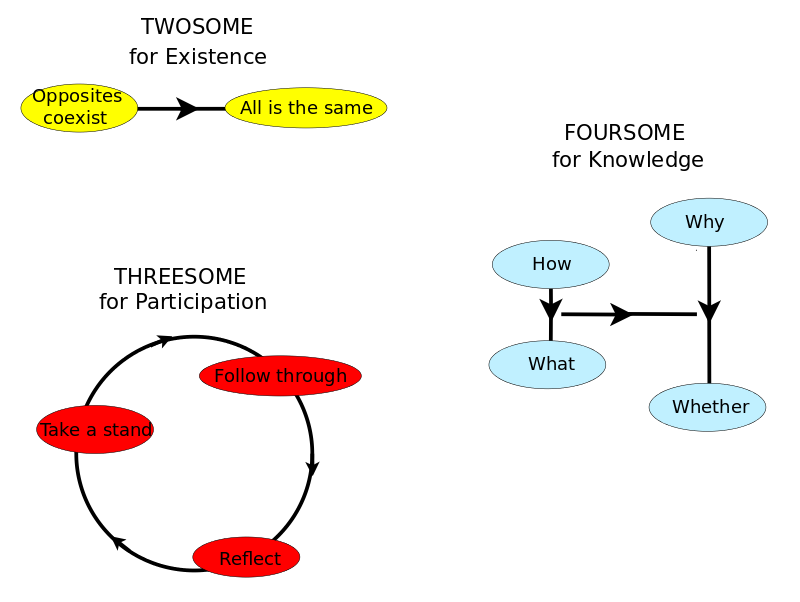
Humans and probably apes are able to divide up our global workspace into a few perspectives which define a particular issue. For example, matters of existence require two points of view: We need to be able to raise a question, does a chair exist or not? but also suppose an answer: If it exists, then it exists; if not, then not. In linguistics, this is the fundamental distinction between construal and content.
Similarly, questions of participation require three points of view: a cycle of taking a stand, following through, and reflecting. Such a cycle is the basis for the scientific method: having a hypothesis, conducting an experiment, and intepreting the results. In linguistics, this distinction between being, doing and thinking is relevant in characterizing nouns, verbs and evaluatives.
Issues of knowledge require four points of view: whether, what, how and why. We experience a cup as a sensory image, What, but also as a mental blueprint, How. We may furthermore imagine Whether the cup is in a cupboard even when nobody sees it. And when we imagine Why there is a cup, then we suppose that we must know its relationships with absolutely everything.
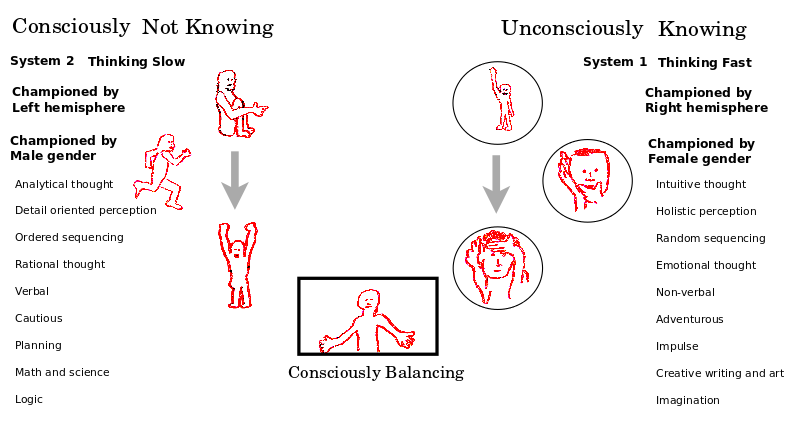
I have systematically catalogued such highly abstract cognitive frameworks which structure the options for our imagination. Decision making requires five points of view and morality six points of view. Finally, the sevensome establishes the logical square which we need for a self-standing system, including the ability to divide and thus define opposites such as true and false or good and bad. The sevensome is extremely important because it establishes the balancing act by which the questions of our conscious mind can be matched by the answers of our unconscious mind.
Our unconscious mind is Kahneman's System 1, the fast thinking, associative mind which always yields the one intuitive answer that summarizes the knowledge of a hundred million neurons. System 2 is our slow thinking, conscious mind which comes up with questions that focus us on what we don't know, and forces us to consider several points of view. We can imagine these as championed by the right and left hemispheres, although what matters is not the particular implementation, but that both mindsets are advocated with equal clarity. Cognitively, our conscious mind governs our unconscious mind, and emotionally, our unconscious mind provokes our conscious mind. The end result will be that we can match the semantics of what our unconscious mind knows with the syntax that structures what our conscious mind does not know.
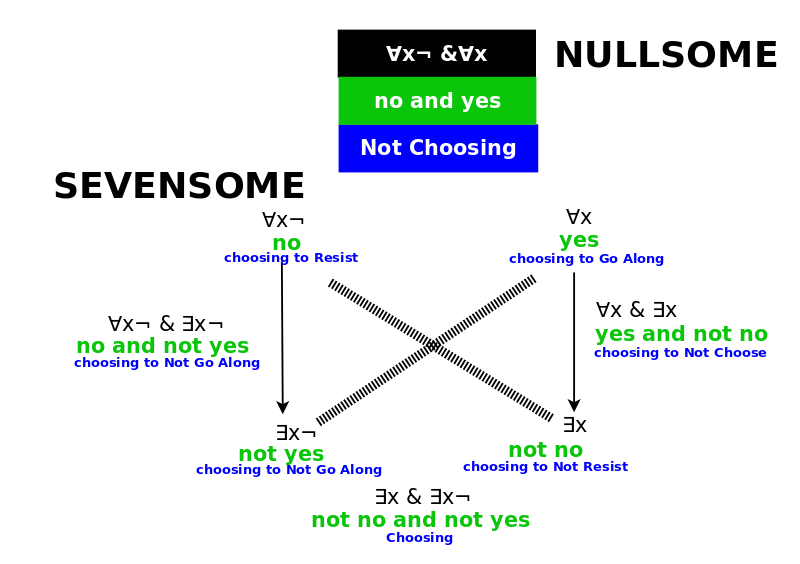
The logic of the sevensome establishes a perfect duality whereby we can equally well think in terms of what is or what is not, what we know or what we don't know.
An eighth perspective would include the possibility "all are true and all are false", in which case the system is empty, it collapses and we have the Nullsome, the division of everything into no perspectives, like a blank page or an empty mind, by which we contemplate issues of God.
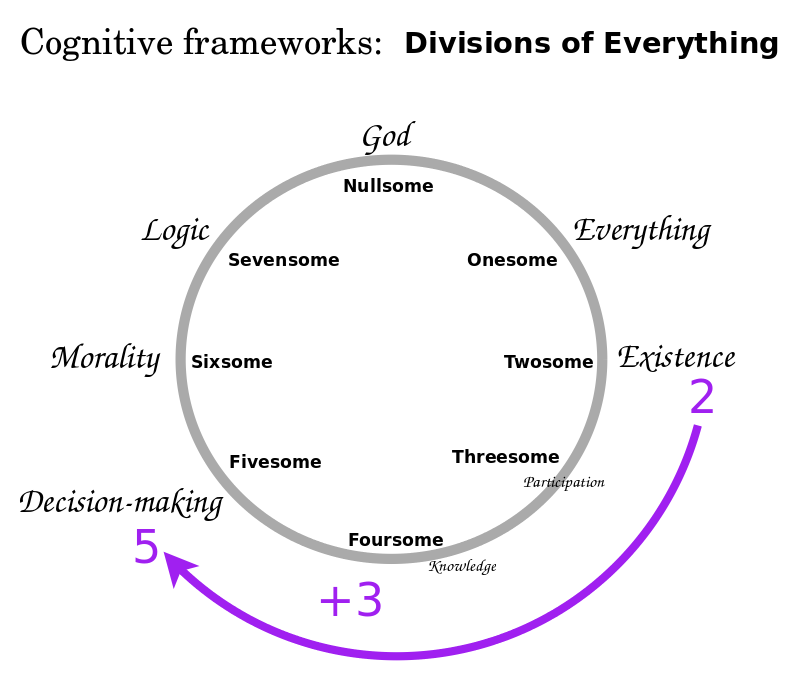
I believe it is possible to model our experience of life in terms of eight highly abstract cognitive frameworks. We move from issue to issue by adding perspectives. Indeed, for consciousness we add three perspectives, for to be conscious of a framework, we need to be able to step into it, and step out of it, and avail ourselves of both possiblities. Thus when we become conscious of the issue of existence, then our state of mind is defined by the issue of decision making.
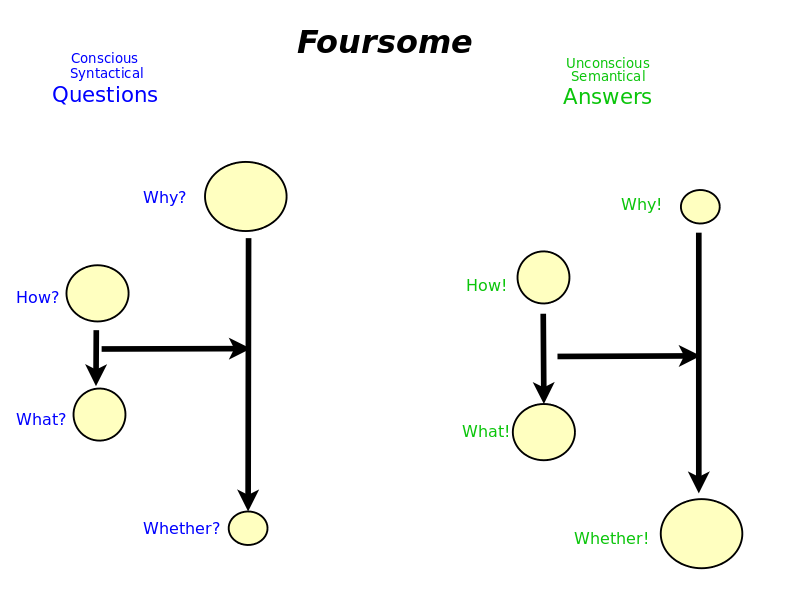
I have further documented the abstract structures by which we experience a perspective on a perspective. For example, the Foursome, the framework for knowledge, has two representations which are important for the distinction between syntax and semantics. Idealists consider the observer's perspective, their questions, what they don't know, and consider Why most important and dismiss Whether as irrelevant. Materialists think in terms of answers, the observed's point of view, what is known, and so for them Whether is most real and they would eliminate Why. Ultimately the two representations allow us to have syntactic variables and semantic instances.
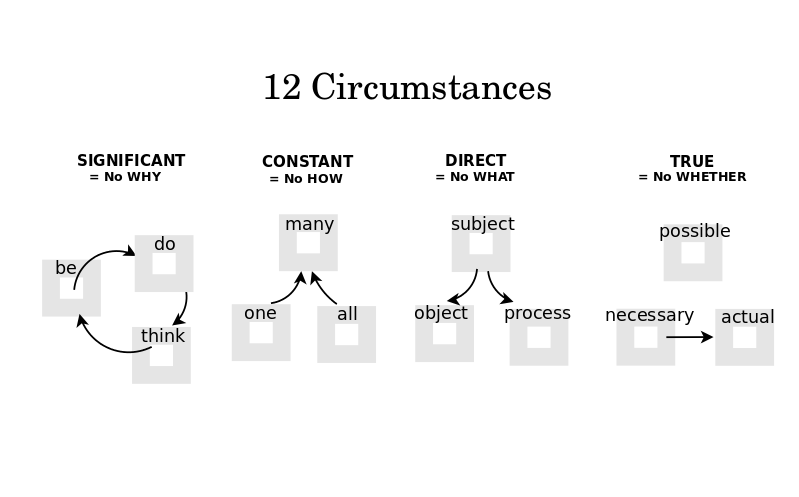
The Threesome, the framework for participation, has four representations. Their twelve perspectives define the vocabulary of our imagination, the circumstances that we can attribute. We derive these twelve circumstances by playing mind games. For example, let us look for constancy. Either we find one example, or all is constantly unconstant. Furthermore, in searching for constancy, we assume that whatever we have selected and evaluated is the same, and so they are multiply constant. With such a mind game we define "one", "all" and "many" as primitives.
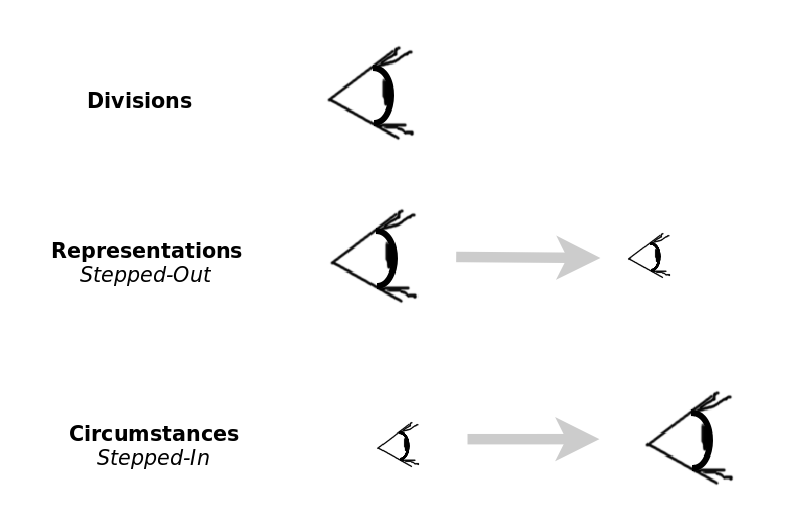
I am describing highly abstract cognitive building blocks. Some of them are frameworks which divide our global workspace into perspectives. Others are perspectives on perspectives, either having us step out, and consider all of our available perspectives, as with the representations, or having us step in, immersed in a particular perspective, as with the circumstances. Over the years I have documented a system of eight divisions, six representations and twelve circumstances which define an abstract world that our minds inhabit. In this tiny world we have the freedom to adjust parameters, that is, to prefer certain values, attitudes, dispositions, options, perspectives, which then influence all of the unconscious decisions, responses and scripts that we follow in the world of symbols, indices and icons which we are immersed in.

Consciousness is our ability to choose whether to step in or to step out. In this sense, apes are likely conscious in much the same way that we are. In many ways, they seem to be as clever as we are.
Michael Tomasello convincingly argues that what makes us human is our joint intentionality, our ability to come together as an ad hoc "we", to conduct an activity on behalf of all, and then to share in the outcome. I will describe this joint intentionality as an expansion of the tiny, abstract world which we inhabit in our minds. I claim that it arises when we conceive of a perspective on a perspective on a perspective. The middle perspective is a shared world that we can improvise. We create and experience that shared world as a game which we enter and leave. We play the game by executing a grammar which expands the ways we may align the semantics of what we know by stepping in with the syntax of what we don't know by stepping out.
I am researching three conceptual languages that this makes possible: argumentation by which issues come to matter, verbalization by which words have meaning, and narration by which events happen. In what follows, I focus on verbalization, the basis for natural language.
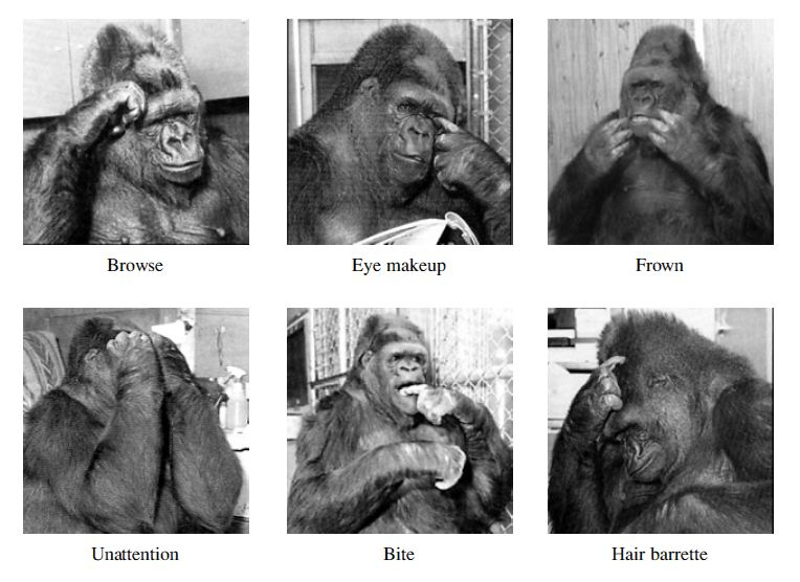
Koko the gorilla makes use of about 1,000 signs and has even invented signs of her own, such as the ones pictured. Koko is able to string words together in intelligent ways. However, she does so without syntax. This syntaxless language is what Roy Jackendoff calls linear grammar. It is characterstic of the pidgin by which sailors communicate, the sign languages which deaf children invent to speak with their parents, the limited way in which some immigrants learn to speak the local language, and the diminished abilities of those who suffer certain kinds of brain damage.
What does syntax add to language? I believe that it allows us to construct a system of perspectives which go beyond what we can focus on here and now. Syntax thus radically expands our ability to acknowledge what we don't understand, not just isolated words, but complicated thoughts which may make sense later or which may prove to be contradictory or simply nonsense. I will show how a universal grammar is presumed in playing games. But first I will make our joint intentionality all the more vivid by suggesting a related physical characteristic by which we diverged from other apes.
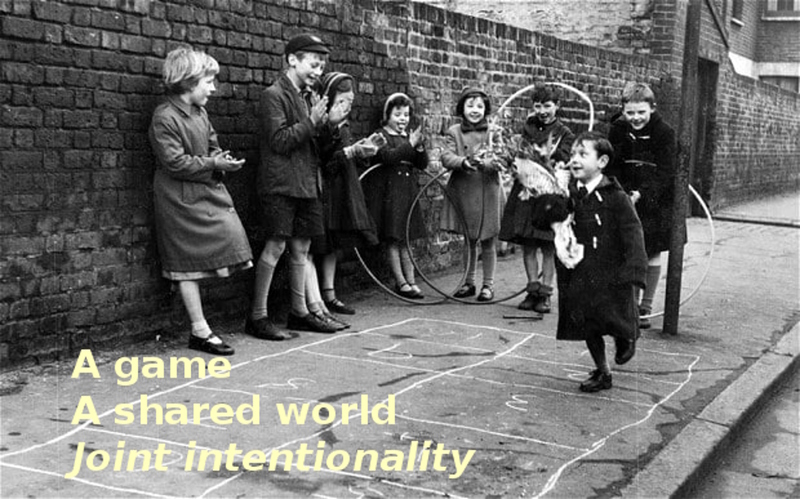
Human games are characterized by the creation of a shared world. Dutch historian Johan Huizinga called it the magic circle. His book, Homo Ludens, considers play the formative element of human culture. Well, many animals play, but truly Huizinga's ideas center on games.
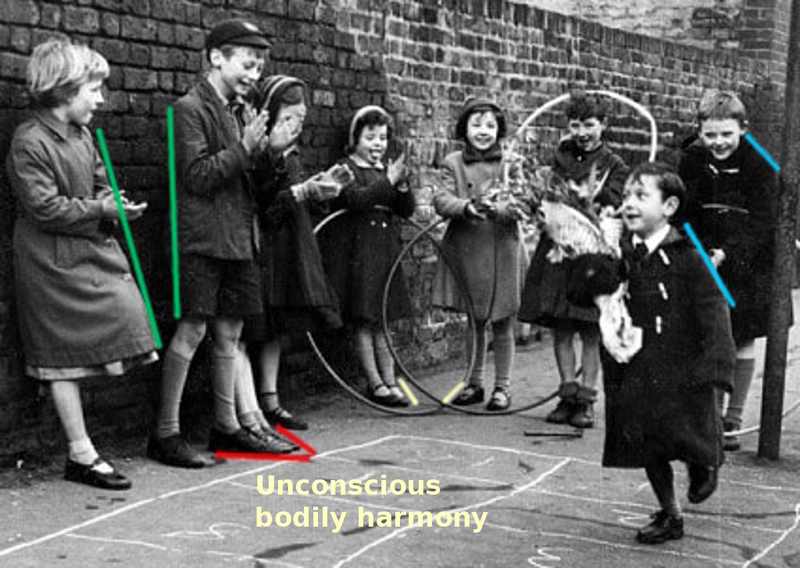
Physically, I believe that our games are facilitated by a bodily harmony, a synchronization of our unconscious movements, as if we were all dancing in slow motion. I have marked some examples of this harmony, which is sometimes called mirroring but is actually much more complex in that our bodies unconsciously acknowledge all of the people around us, as we can surely see if we look around this room.
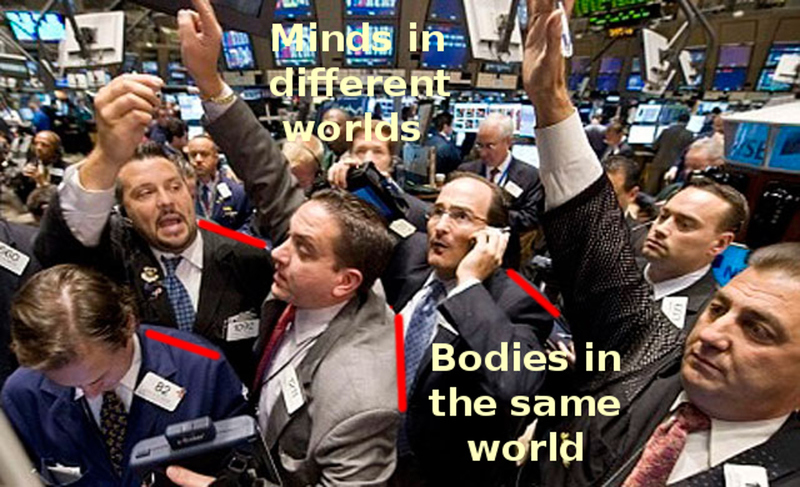
Our bodies seek this harmony even when we compete against each other or when our thoughts are in different worlds.
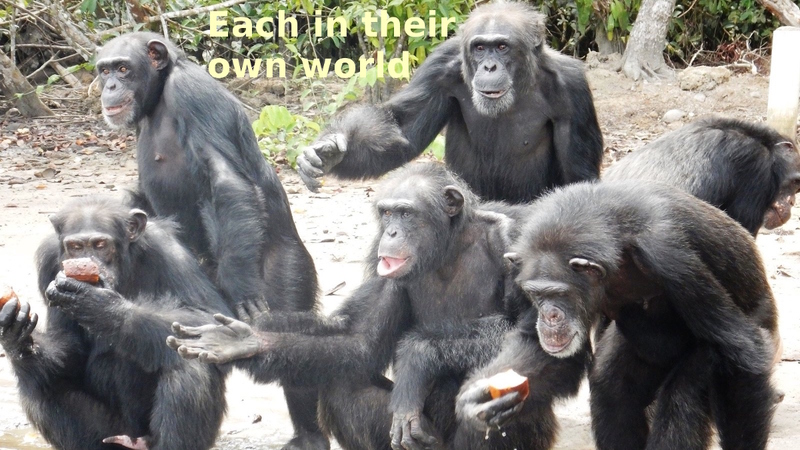
As Tomasello has noted, chimpanzees play different roles in a team, for example, in hunting a monkey. One chimpanzee may chase the monkey from above and another from below. But each of the chimpanzees is thinking - that is my monkey! - and does not expect to share it, should it capture the monkey. Chimpanzees are not loyal to the task at hand, and can get distracted by something more enticing. As we see in this picture, each of these chimpanzees is in its own world.
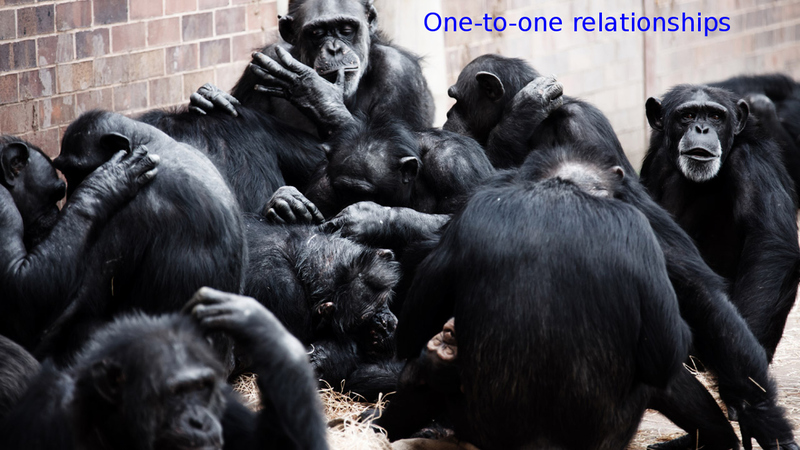
Note in this picture of chimpanzees together that they are not actually focused on the group but on their one-to-one relationships within it. Gorillas do play tag but I suspect it is a one-on-one activity.
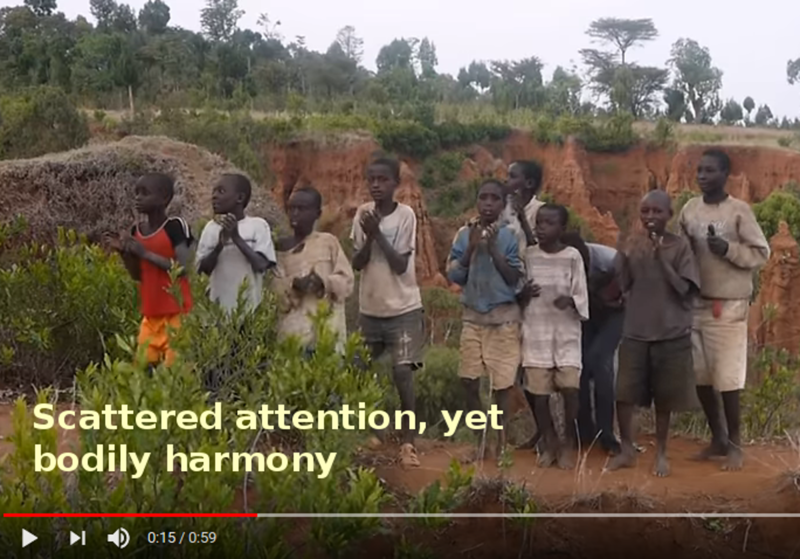
Whereas in this picture of Ethiopian children singing, we see a wonderful harmony in how they naturally arrange themselves, even though their attention is scattered in different directions. Thus I imagine that this human "sixth sense" may have coevolved as the basis for our joint intentionality. Such a sense may have genetically arisen in identical twins, and their coordination may have been sexually attractive, fueling a virtuous cycle of evolution. Humans may have learned to establish and sustain joint intentionality through singing, drumming and dancing in unison, perhaps while foraging, and perhaps to foster a shared mindset before a hunt and afterwards as well. Such activity could have driven the evolution of our vocal cords, our hands and our posture.
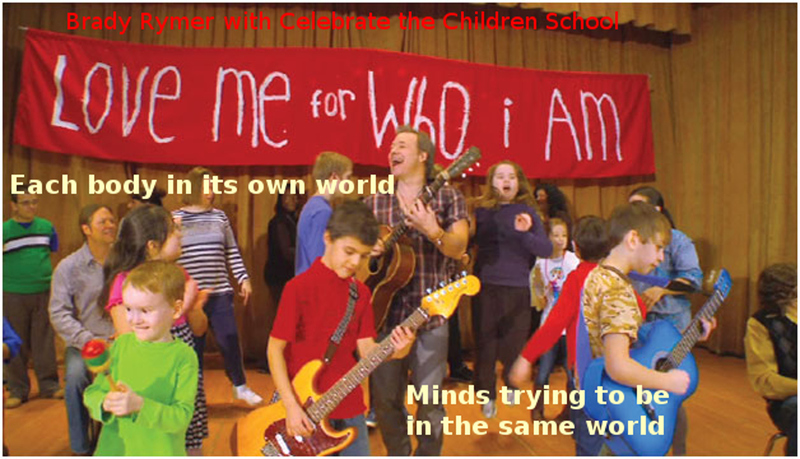
Autistic people seem to be lacking precisely this physical faculty. It is as if they are blind or deaf with regard to this sixth sense. Such a physical disability would make it hard for them to join with others in a shared world.
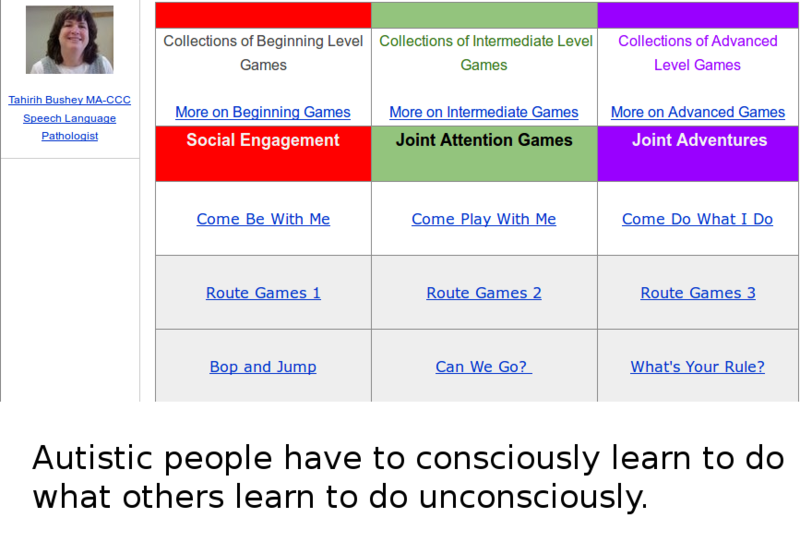
Autistic people face the challenge of consciously learning the cues for joint intentionality which the rest of us master unconsciously. "Come be with me", "Come play with me", "Come do what I do" are games to develop joint intentionality.
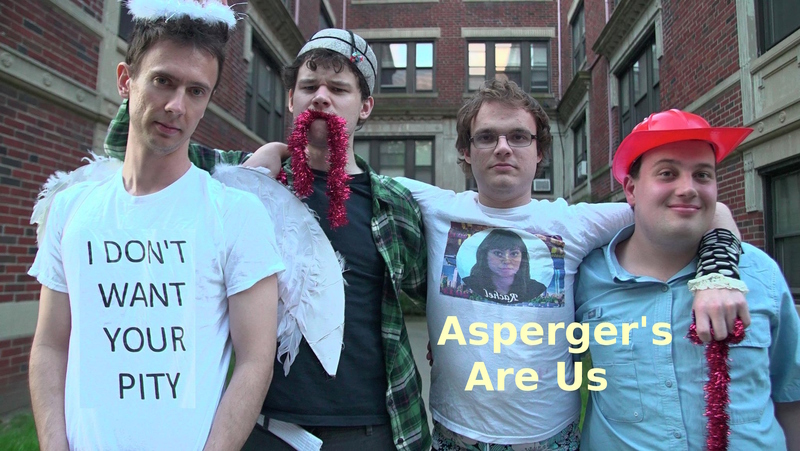
Autism is, in fact, a spectrum, including Asperger's syndrome, which by this analogy, suggests that some may lack this "sixth sense" to a degree, just as I myself am poor of sight.
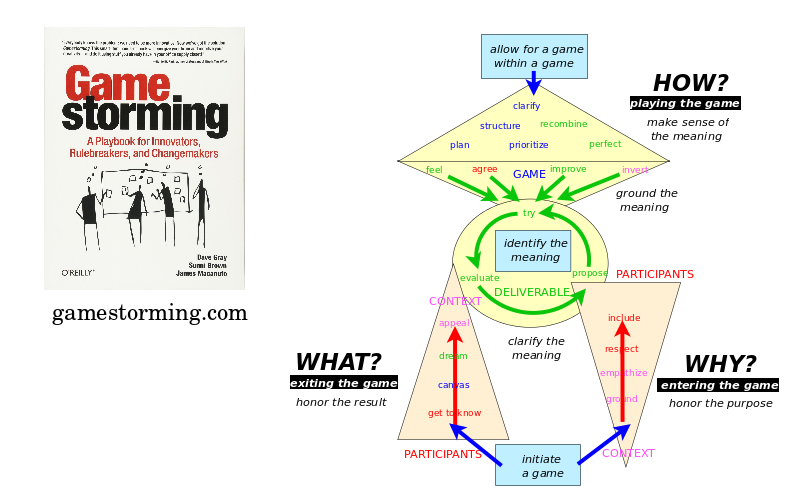
I will now present a wonderful source of anthropological data about games. I will use this data to propose a Universal Grammar for games and all human activity for creating meaning, including human language.
Dave Gray, Sunni Brown and James Macanufo are consultants who wrote a book called Gamestorming and have a related website. They have collected about 100 innovation games played in Silicon Valley to help corporate teams function creatively. Different games serve different purposes and I became interested in how those purposes might come together as a framework for innovation, or more broadly, figuring things out.
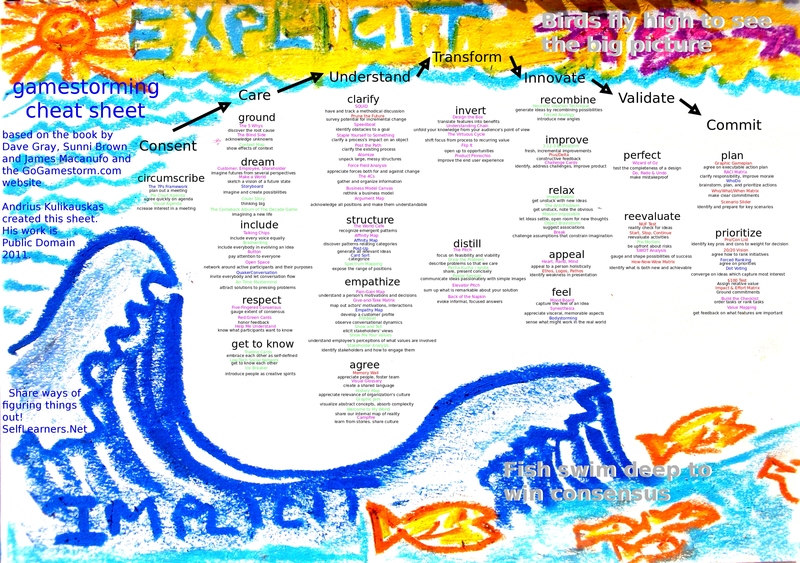
In my first attempt to diagram the purposes, I noted how they unfolded. We may start with games for consenting, for caring about each other and the issue, and for understanding the issue. The climax of innovation is when we distill the idea, for example, when we can draw it on the back of a napkin or explain it in an elevator pitch. Often this comes from inverting our point of view, for example, taking up the customer's point of view. After we gain this new perspective, there are games that help us innovate, validate and commit ourselves.
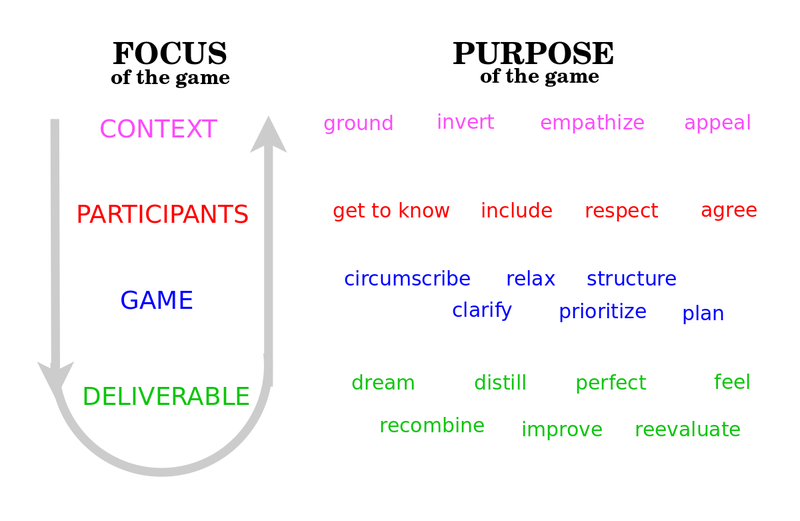
I then took a fresh look to consider what we focus on with these various innovation games. Some of them have us focus on the bigger picture, appealing to the real world. Others have us focus on our fellow participants, getting to know them, respecting them and including them. There are games that have us focus on the games themselves, that is, the rules for the innovation process. And, ultimately, there are games which have us focus on the deliverable, that creative output which is the goal of the creative process, and from the company's point of view, the product or service that it hopes to sell. Thus we can think of the innovation framework as itself being a game, which first has us set up the preconditions for creativity, then has us create our deliverable, and finally has us return with that deliverable back into the real world.
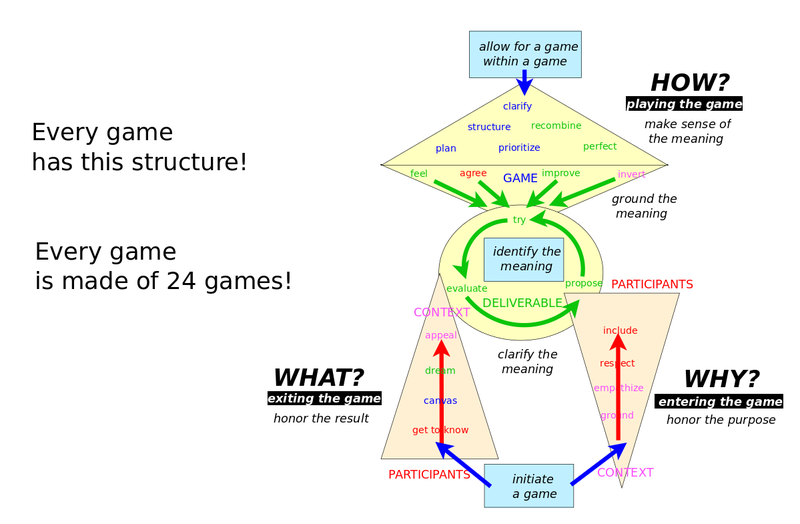
But this suggests, vice versa, that every game may potentially be considered as an innovation framework for games within that game. I saw that I could organize the games into 24 groups based on their purposes. The resulting structure is one that I had recognized earlier in studying the ways of figuring things out.
First, there are games for initiating a game. There are also games which let us start a game within a game. There are games which identify the meaning of a game. There are three kinds of games for a learning cycle by which we clarify that meaning. There are four kinds of games for grounding that meaning in the real world on four different levels. There are six kinds of games which make sense of that meaning by making sure those four levels are distinct. There are four kinds of games for progressively entering into the game and honoring its purpose. And there are four kinds of games for progressively leaving the game and honoring its outcome. Thus there are 24 games in all within every full fledged game.
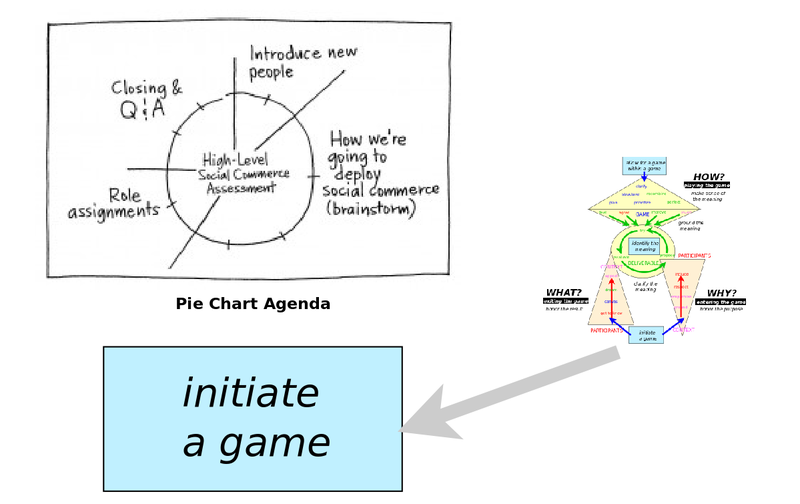
I will start by talking about a quick innovation game, the Pie Chart Agenda, which is used at the beginning of meetings. The participants agree on how to organize the agenda for a meeting by drawing it visually as a pie chart which shows what items will be considered and proportionately how much time will be given to them. We can say this is a game for initiating a larger game, for gaining consent. But we can also think of it as calling out the name of a game and commanding it into being. A game can be initiated without words, simply showing up at a basketball court with a basketball, ready to play. In linguistics, we can open our mouth to say a word, clear our throat before we start a sentence, or say an introductory phrase like "Hello."
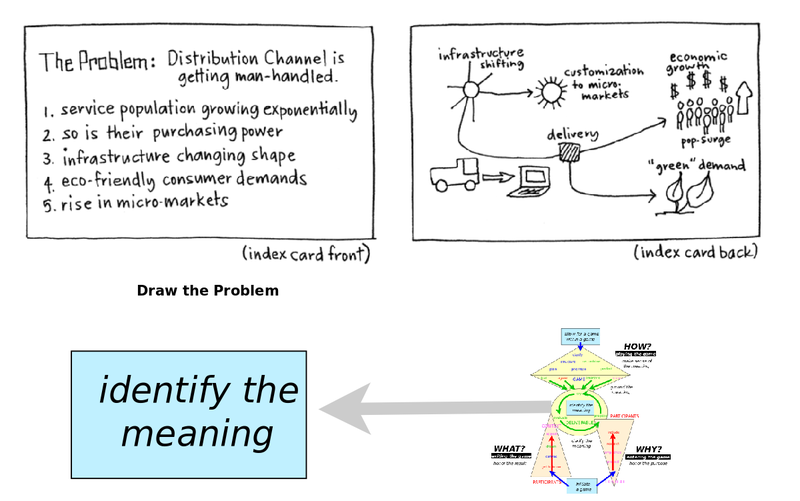
At the heart of the innovation process are the games that distill the essence of the deliverable. Such games include "Draw the Problem" where we illustrate a problem in a way that would make us care. In a basketball game, the essence might be the final score but it might also be a defining moment. The goal of coming up with a deliverable induces the familiar grammatical distinction between subject, object and verb. A participant is a subject, and their activity is a verb, but the deliverable is an object. This suggests that the object is the whole point of talking. And it shows the importance of the passive voice in that it converts the participant into the deliverable, which is to say, the participant becomes important and we empathize with them. The claim is that "me" demands empathy and "I" does not.
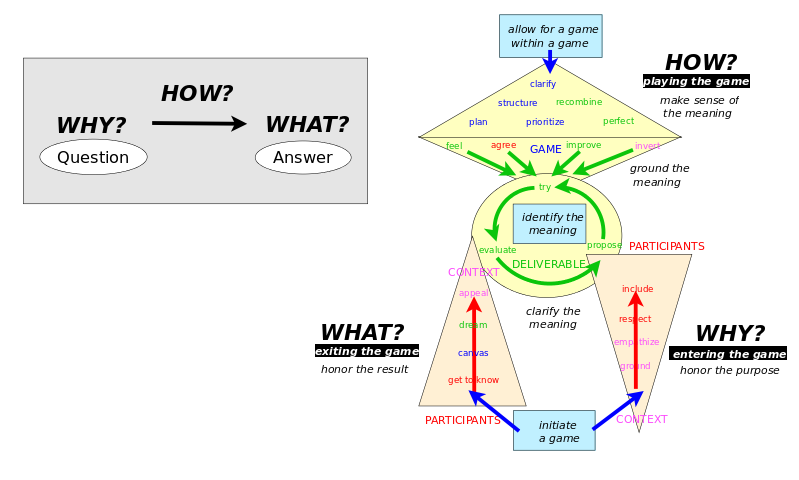
In terms of the big picture, we enter a game with a question, we play the game, and then we leave the game with an answer. The question is the reason Why we play the game, and the answer is What is the outcome of the game. In a basketball game, the question may be, Who will win? and the answer is whoever won. Within the game, we focus on How to play it. Of course, we could shoot baskets without keeping score and simply end our play when it is time to go home. So long as we create a shared world which we enter and then leave, we can call it a game. The question could be, How could we kill some time? and the answer could be, That was kind of fun.
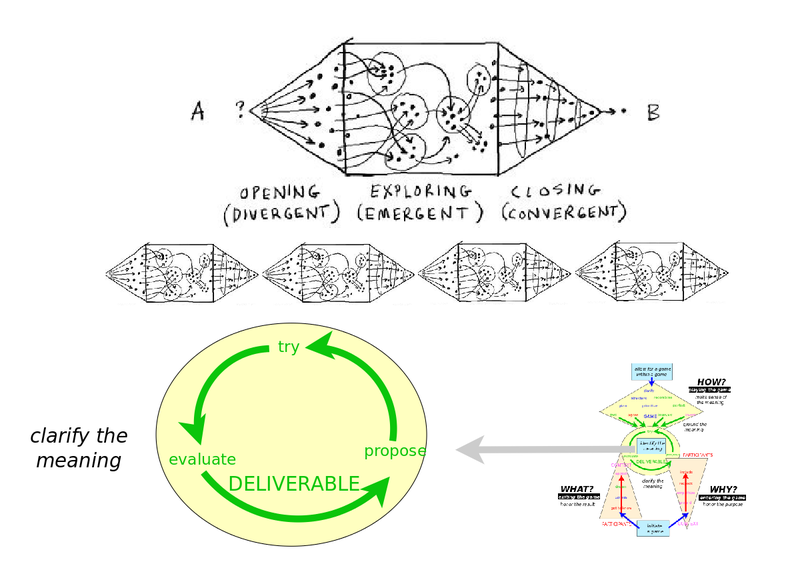
Every game thus has three phases. In chess, they are called the opening, middle game and endgame. There are innovation games which start the creative process by asking questions. The question opens up our thinking and allows it to diverge. Then there follow games which explore various angles and seek for a new idea to emerge. Finally, there are games that have us converge upon an answer. In linguistics, we similarly distinguish between nouns, verbs and evaluatives.
The three phases accord with the learning cycle of proposing an idea, trying it out and evaluating it. Such a cycle leads to increasing clarity. And it can be repeated over and over again. We can return to the same question or consider a new question. We can string together different games if every one of them has a clear beginning and a clear end. In a similar way, we can concatenate sounds, syllables, words, clauses or sentences.

Once upon a time, I was wondering whether it made sense for me to finish my Ph.D. studies. My mother advised me, "You want to be a person who starts what he finishes". And this general principle is known as the House Rules. If you open it, close it. If you turn it on, turn it off.
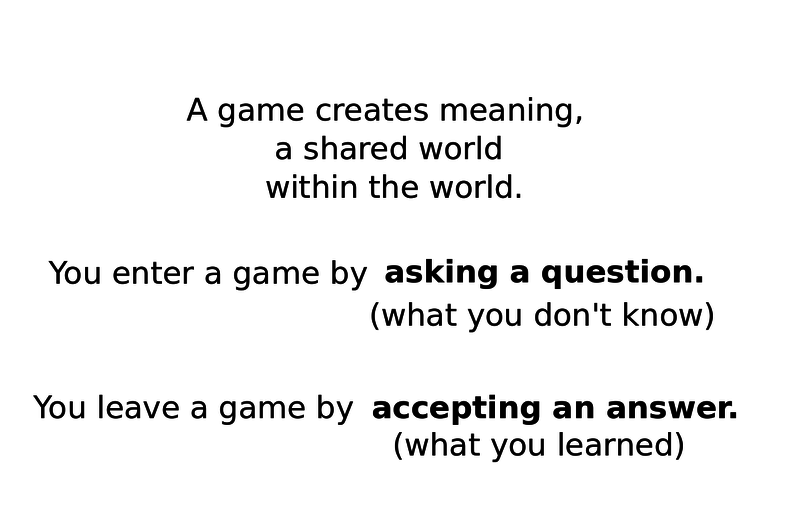
In general, if you enter a game, then you should leave the game. You enter a game by asking a question, what you don't know, and you leave the game by accepting an answer, what you come to know. This his how we relate our conscious not knowing and our unconscious knowing. We establish a shared world, create meaning within it and then bring it out with us.
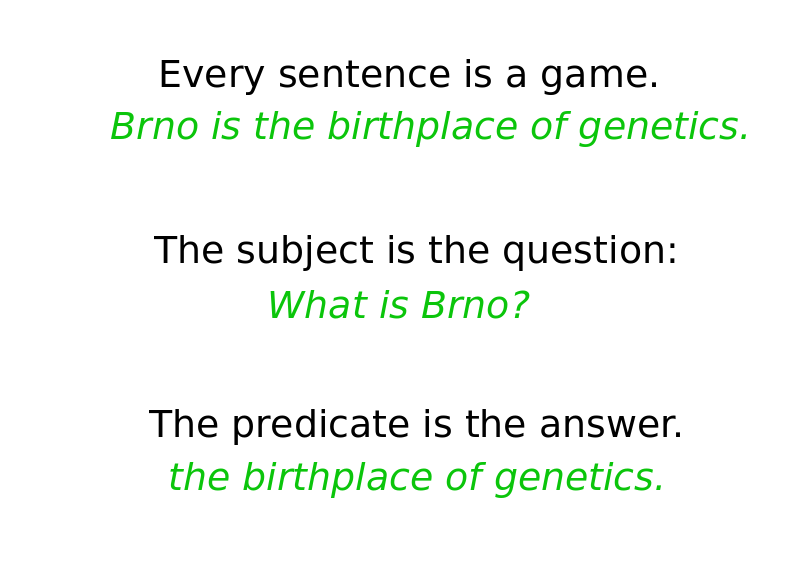
It makes sense to think of every sentence as a game. The question is given by the subject or topic. The answer is given by the predicate or comment. It is thus troubling to hear a subject without a predicate, unless that subject is the reply to a question. Whereas a predicate can stand on its own, with the subject implied.
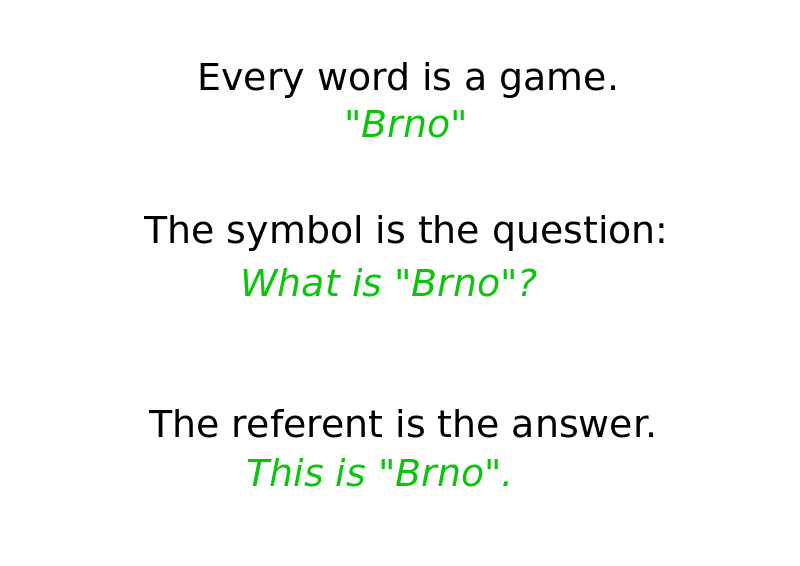
Similarly, every word is a game. A new word, "Brno", makes me wonder, What is Brno? I need to learn from somebody, "This is Brno." But the true meaning of Brno for me will be some personal impression that I distill, which is the point of that game.
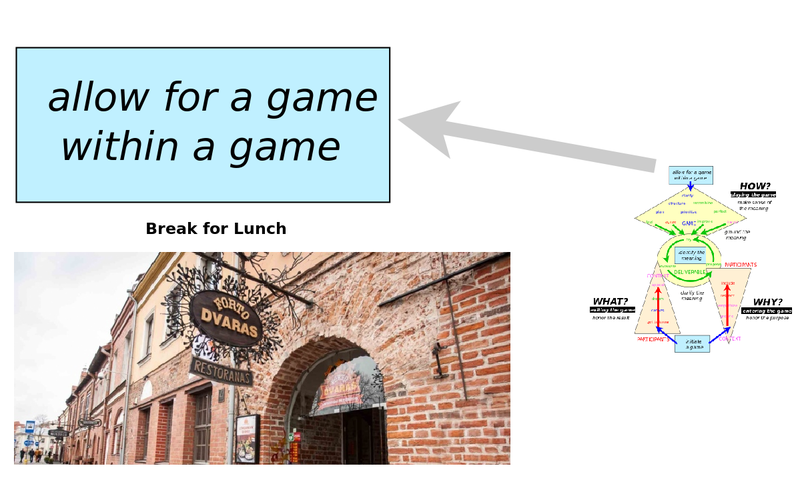
What makes the creative process very powerful is that there can be games within games. Or more precisely there are games which make room for such games. For example, there can be a lunch break, which lets us relax and can inspire our creativity.
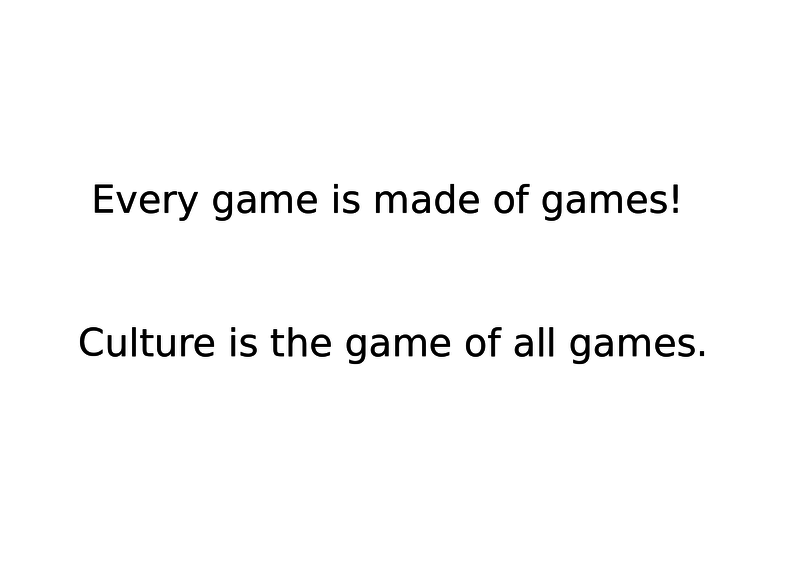
In this way, there can be words within words, or sentences within sentences. We start to realize that everything is a game, subject to the same grammar. Our culture is the game of all games.
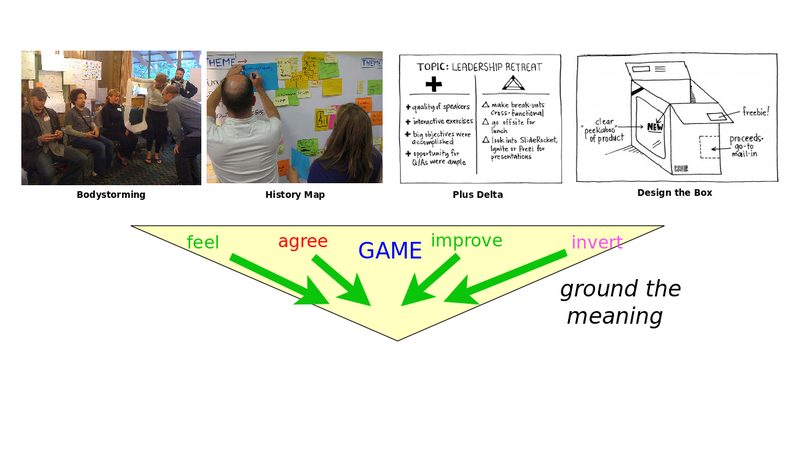
There are innovation games which ground our meaning in the bigger picture. Bodystorming has us physically feel the implications of our ideas. History Map has us appreciate and acknowledge our corporate culture as the basis for agreement. Plus Delta has us incrementally improve by acknowledging what is good and what could be better. Design the Box has us invert our perspective by considering the customer's point of view.
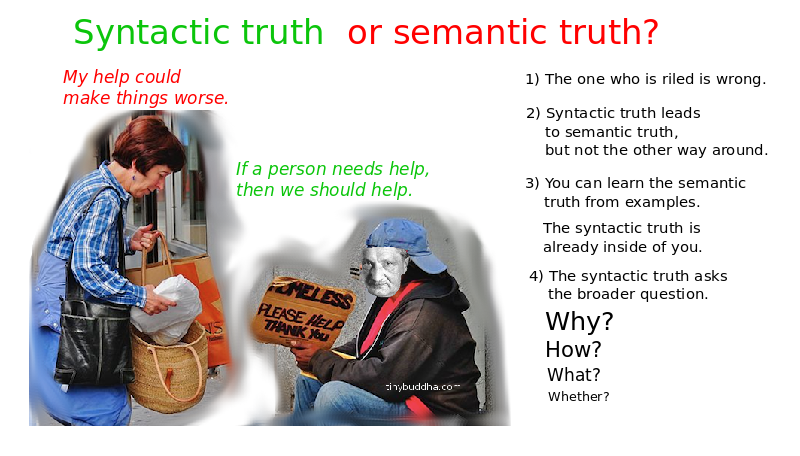
These four games are dialectics which help us distinguish the semantic truth and the syntactic truth. The semantic truth is the conditional truth of the game, which expresses what our unconscious mind knows. The syntactic truth is the unconditional truth beyond all games, which expresses what our conscious mind does not know. Both truths are true, but they pull us in different directions. We should focus on the syntactic truth as the relevant truth and live in terms of what we don't know. Syntax makes semantics relevant, but not the other way around.
For example, there was a time when I felt riled in my encounters with the homeless. They would ask me for money, and I felt that I was in a game that was wrong. I believed that my help could make things worse. But then I realized that there was another truth, that if somebody asked for help or needed help, then I should help. I came up with four tests which distinguished the narrower semantic truth of the game from the bigger syntactic truth. The first test was that I was feeling riled and so I was thinking wrong, I had confused the two truths. If I was thinking right, then I would feel calm. The second test is that the syntactic truth leads to the semantic truth, but not the other way around. If I try to help, then I won't want to make things worse, but if I focus on my help not making things worse, then I will never help anybody. The third test is that we can learn the semantic truth from examples - I can describe how my help has made things worse. But the syntactic truth is tautological, we can't show it and it must have always been inside of us - there is no way to show that we "should" help others. Finally, on any subject, such as helping others, we can consider four questions: whether, what, how and why, and the syntactic truth always asks the broader question. What help do we give - we don't make things worse. But why do we help - because we should. I have found these four tests to agree. We can think them of them as looking at the game from within it and beyond it, entering it and leaving it.
In basketball, this means that you should not cheat, but play fair. In linguistics, it means that different factors can redeem a sentence or make it unacceptable, including our greater or lesser processing power, the abundance or lack of relevant context, syntactic flexibility or violations, and inspiring or confusing stylistic emphases.
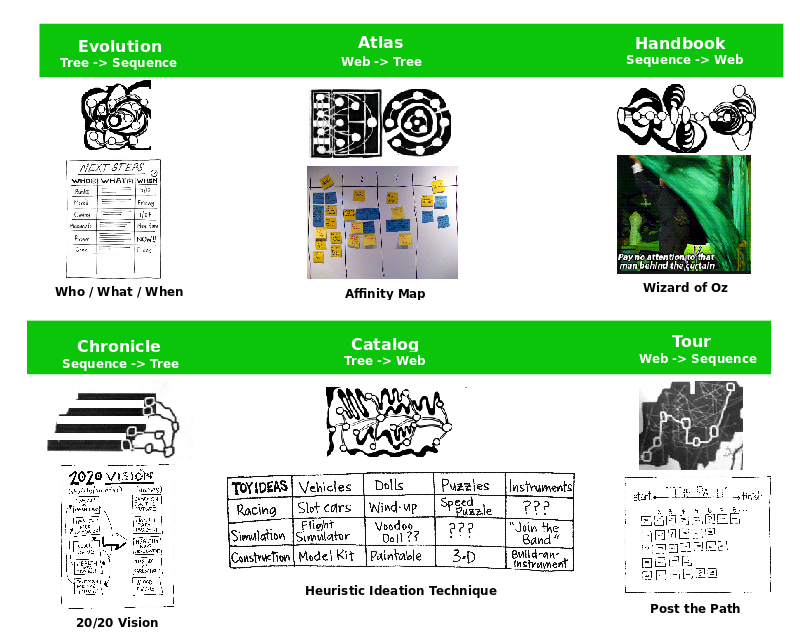
There are six innovation games which are almost purely syntactic in that they focus on the game itself. They reorganize and visualize the components. Note that our unconscious mind is built from a network of associations, whereas the grammar of our games allows for sequences of games - horizontally, games after games - and trees of games - vertically, games within games. Thus there are games which take a large structure which our unconscious has mastered - a sequence, tree or web - and restructure it with a smaller structure that our conscious is exploring. This yields six familiar visualizations but also six paradoxes which highlight the gap between the structures. Thus these games give us intutition by highlighting inherent paradox.
- Evolution: A hierarchy (of variations) is restructured with a sequence (of times). The paradox is that concepts may be inexact.We can't specify exactly at what point in the womb a child becomes conscious, or at what point in evolution two species diverge.
- Atlas: A network (of adjacency relations) is restructured with a hierarchy (of global and local views). The paradox is that the whole is not the sum of the parts. If we replace all of the parts of an automobile, and then build a copy with all of the old parts, which is the original?
- Handbook: A sequence (of instructions) is restructured with a network (of loops and branches). The paradox is that our attention affects what we observe. Achilles can never catch a tortoise if we keep measuring the distance between them.
- Chronicle: A sequence (of events in time) is restructured with a hierarchy (of time periods). The paradox is that there may be a limited contradiction. How can we reliably learn from one who has ever made a mistake?
- Catalog: A hierarchy (of concepts) is restructured with a network (of cross-links). The paradox is that we cannot make explicit all relevant assumptions. 10+4 may equal 2 if we happen to be thinking about a clock.
- Tour: A network (of states) is restructured with a sequence (of steps). The paradox is that we can choose differently in the same circumstances. "I am lying when I say 'I am lying.'"
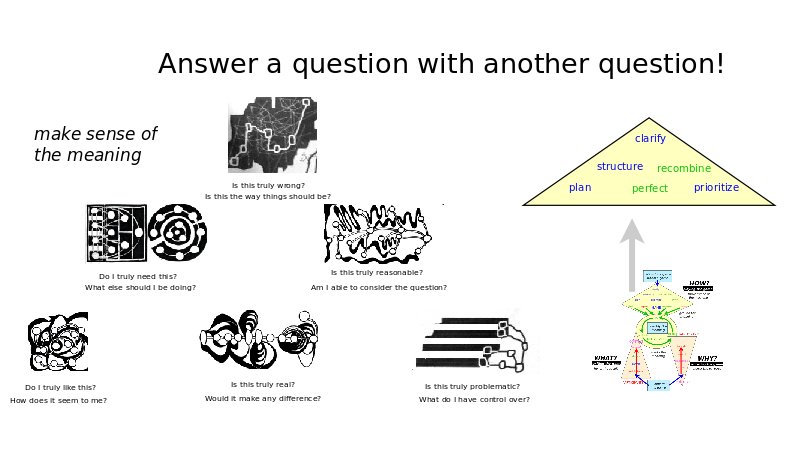
What these games are doing is answering a question with a question, which is to say, extending syntactic obligations with more obligations. Linguistically, I think this could describe how we construct microobligations as we roll out our sentences. The fact is that when we start speaking a sentence we may have no idea how it is going to end. This shows that the traditional syntactic views are absurdly false. Instead, it seems clear that as we construct our thought, we variously commit ourselves and have to keep talking until we satisfy all of our commitments to ourselves and others. For example, if we start out, "Please give me some...", then we cannot continue with the word "bottle". Such commitments include tracking case, tense, number, gender, using definite or indefinite articles, and measure words. It is curious that, in practice, there are no simple languages, so that Japanese seems to compensate for its regularity by using a dauntingly complicated set of honorifics. I suspect the reason is that these microobligations are precisely what allow us to unpack first the syntax and then the semantics of a sentence as we keep track of what we are hearing.
Answering a question with a question is a way of freeing ourselves from semantics. There are situations where we can't rely on anything we know. For example, how do I know that if I say "whizzlesticks" this building won't collapse tomorrow? I reply with a counterquestion, What do I have control over? If the building is so curiously designed, can it truly be my fault? Indeed, there are six such counterquestions which distinguish the four levels of knowledge, and help us get by without any semantic knowledge.
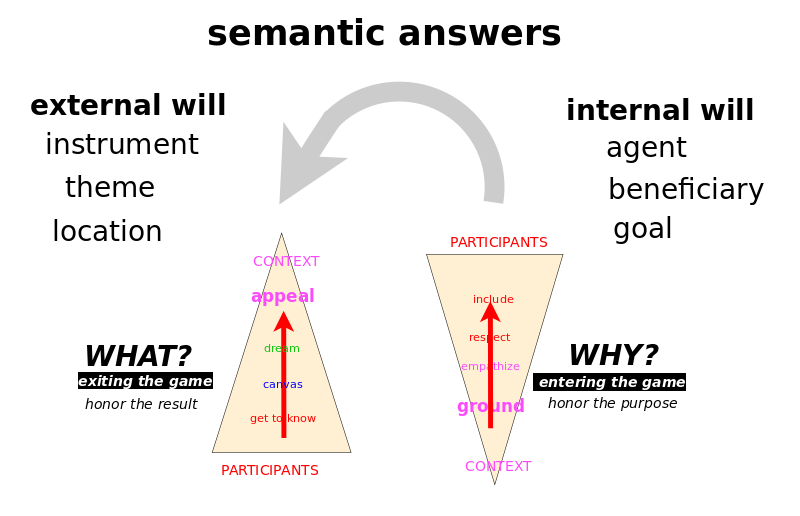
Finally, there are four games by which we enter into a game and four games by which we leave it. These are games that have us honor the purpose, Why we are playing the game, and honor the outcome, What we got out of it.
I think these eight games straddle the two representations of the Foursome, the questions that we consciously ask and the answers which our unconscious provides. We enter a game asking a question, and we leave it with some answer. Semantically, in the big picture, it must all relate to other people. And the game represents a shift in our sense of agency. The innovation game "5 Whys" has us chase down the reason for why we're playing, the why upon why upon why upon why upon why. But then we have to likewise empathize with others, to respect them and include them, and there are games for all of that. By the time that we leave the game, our focus has shifted to what we have achieved with others, to their dreams, their positions, and their self-definitions. And this lets us appeal to a bigger audience, the broader society, or the corporate customer out there.
What this means is that our sense of agency shifts. Syntactic thinking allows us to convert our internal sense of agency in terms of agents, beneficiaries and goals, into an external sense of agency in terms of instruments, themes and locations. But these are precisely the six levels of the Kiparsky gradation of thematic roles, and closely related to the case system underlying Indoeuropean languages. Thus the case system appears to be conveying the most basic semantic distinctions.
Such semantic distinctions may also be natural to memory. In studying spoken and written languages, it is amazing that the most irregular words or characters are typically among the most common. It is precisely the uncommon words which tend to have regularities. But this makes perfect as we think of memory as a set of compartments waiting to be filled. If we have an empty compartment, then we can remember from a single occurence that something fits within it. And we seem to remember not what satisfied the compartment, but rather, we recognize that we have a compartment that we didn't know about before. It doesn't really matter what fills the compartments until we start to lack room. Then in order to squeeze things in we have to discover regularities. This simple theory explains why it is easy to learn a first language but why it is difficult to learn a second language if all of the relevant compartments are already filled.
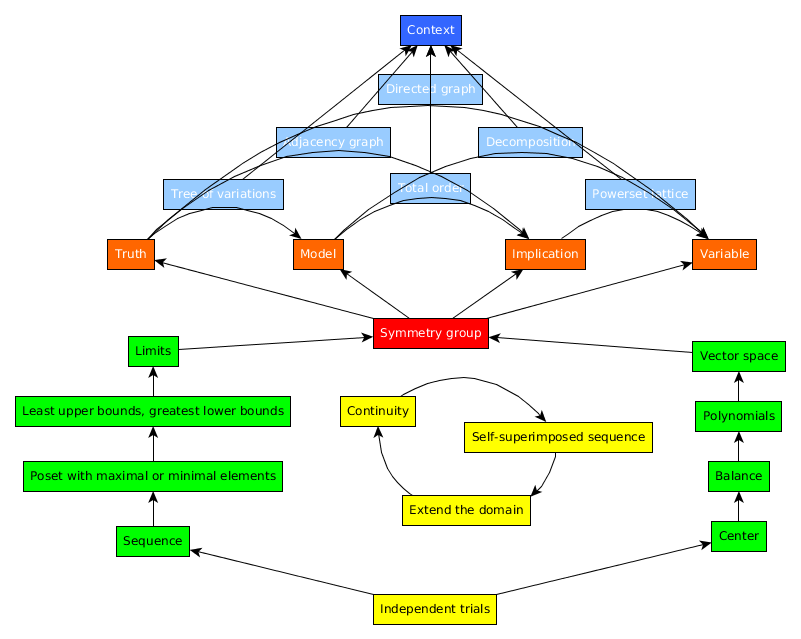
I first worked out this overall system in documenting and systematizing the ways of figuring things out. Indeed, it very nicely organizes the techniques involved in solving mathematical problems. I think we'd get the same system if we looked at the ways of figuring things out in physics, medicine, business, or any other discipline, or those used by any particular individual. That's endlessly worthwhile to explore.
Such a universal grammar for creating a shared world and, indeed, for figuring it out, is precisely what is needed for children to learn language. A universal system means that they know the various ways they should try to find meaning and make meaning, to understand others and to be understood.
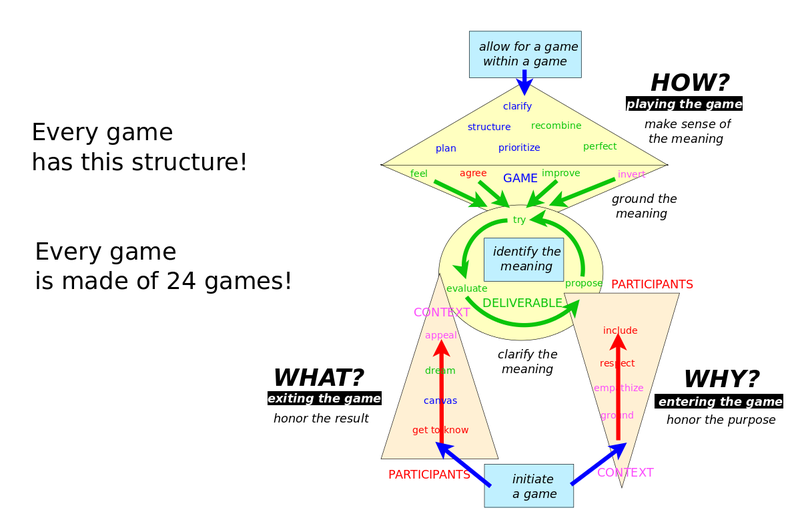
I hope to have shown that innovation games are very helpful anthropological data because they invariably have a purpose which lets us know where they might fit in a broader game. We can think of our entire culture as a game that we could engineer together.
Indeed, we can think of our life as a game, where we ask, What is the meaning of life? or simply, Why are we here? And our life ends, in one sense, when we know ourselves, our reason why we do what we should do, our deepest value, which includes all of our other values. But it begins anew, as an eternally unfolding life, in that we dare to live by asking questions, by focusing on what we don't know, but would like to discover.
